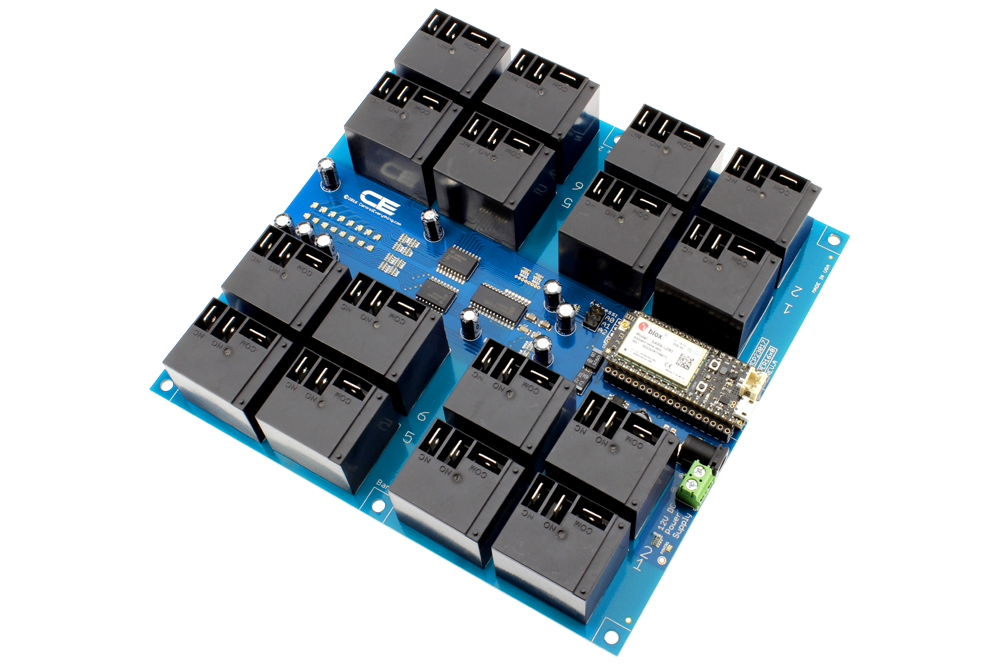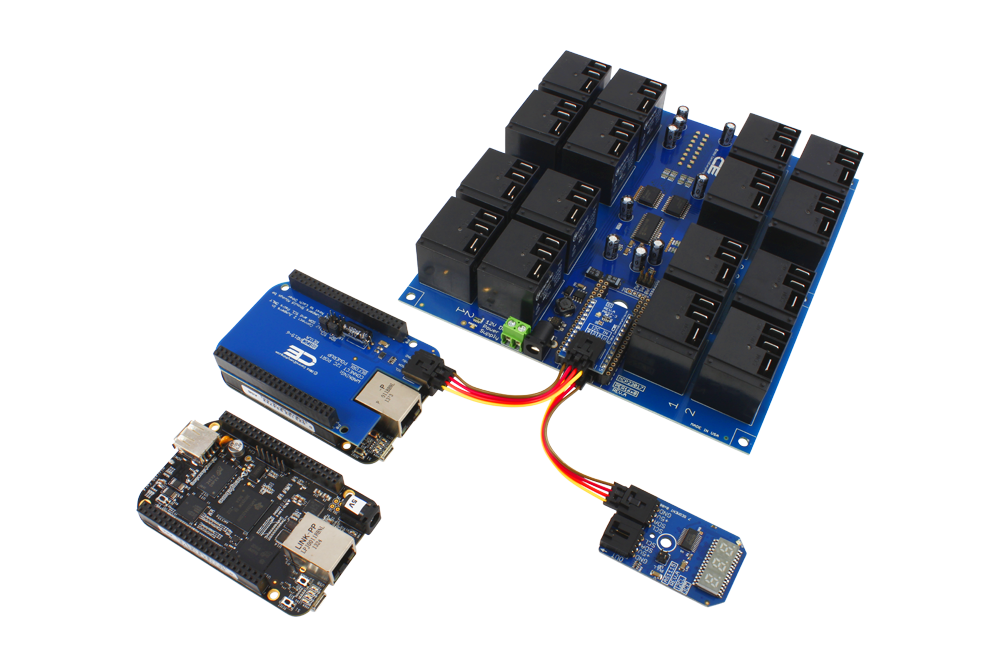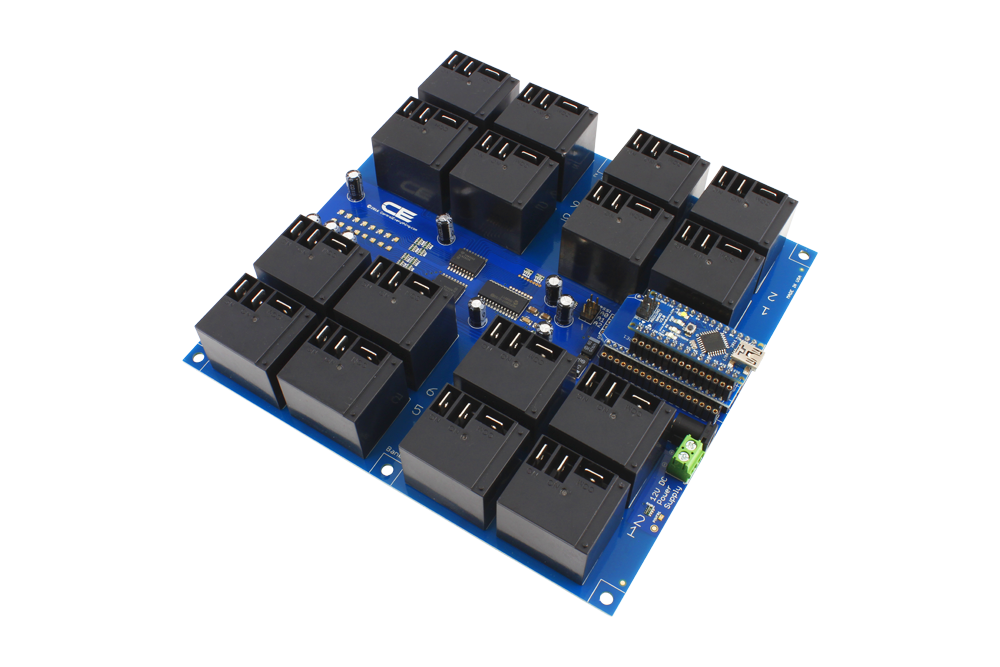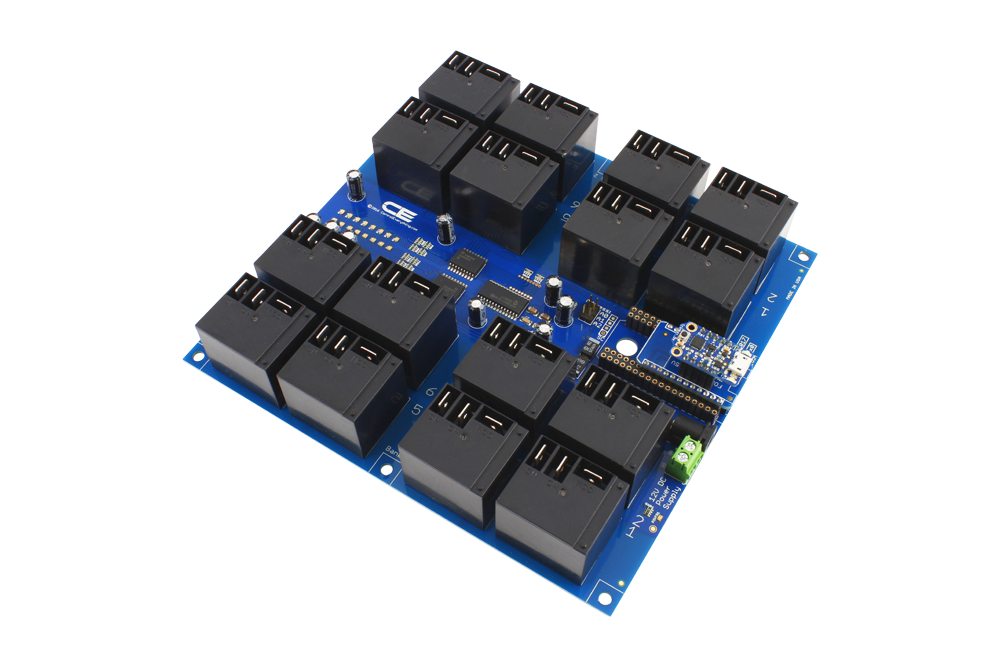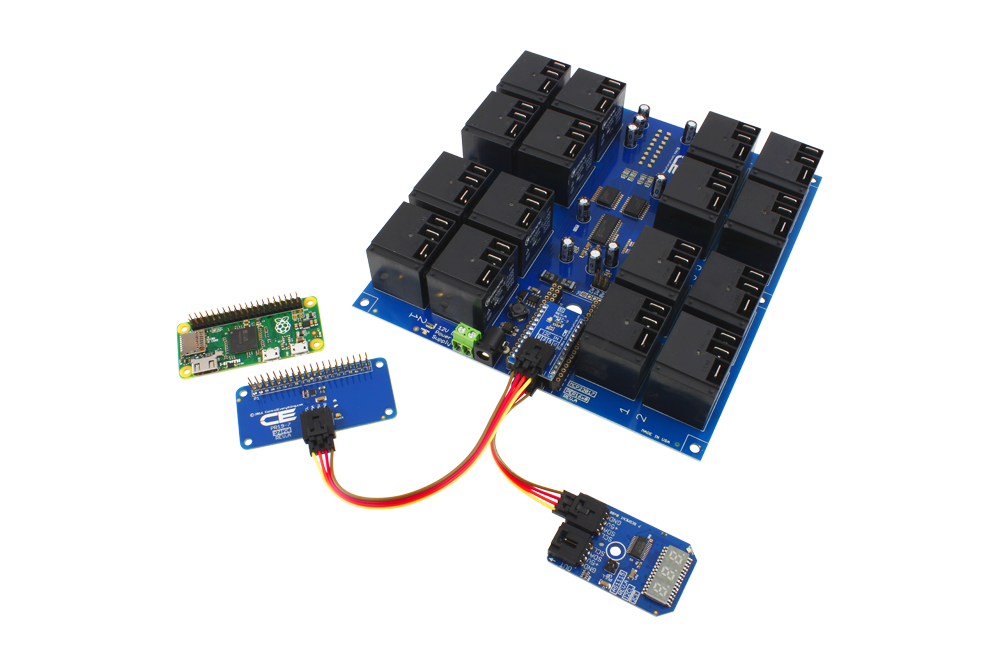16-Channel High-Power Relay Controller Shield with IoT Interface
Highlights
- 16-Channel High-Power Relay Controller with IoT Interface
- Compatible with Electron, Photon, Bluz, or RedBear
- Adaptable to Onion, PyCom, Raspberry Pi, Arduino
- MCP23017 I2C Controlled Mechanical SPDT Relays
- Available with 20-Amp SPDT or 30-Amp SPST Relays
- World’s Most Expandable Controller with I2C Expansion Port
- Wireless Remote Operation with Key Fob Expansion Option
- ESP8266 and USB IoT Interface Modules are Also Available
- IFTTT Firmware Available for Internet Relay Control
- Example Libraries Available on GitHub
This IoT 16-channel high-power SPDT relay controller is capable of hosting many types of IoT communication modules, including Particle Photon, Electron, Arduino, and more. On-board relays are ideally suited for control of high power loads up to an absolute maximum 30 Amps at 240VAC, depending on relay chosen during purchase. This design is suitable for some mildly inductive loads when used with external induction suppression capacitors, but focuses primarily on resistive load switching. This controller includes 20-Amp SPDT or 30-Amp SPST relays, customized when added to your shopping cart.
This controller is based on the MCP23017, a common I2C interface chip for GPIO applications. In this design, the GPIO port is used to control the on-board SPDT relays. Three on-board address jumpers allow up to 8 similar devices (based on the MCP23008 or MCP23017) to be chained to the same I2C bus for individual control. On-board status LEDs display the on/off status of each relay. This controller may be powered using our optional power supply or with 12VDC and direct screw terminal connection of bare power wires.
IFTTT
Leverage the power of IFTTT.com and Particle services to do almost anything. Send a tweet if someone rings your doorbell, send a notification to your phone if someone opens a door, turn on almost anything right from your phone with simple setup, the possibilities are endless. NCD provides this controller with a optional pre-programmed Particle Photon module for easy connection to IFTTT. No programming required! Just use the simple IFTTT interface to setup your different configurations.
Powered By Particle
Give your Particle Photon the power to interact with the real world in ways never before possible. Use the optional Particle Photon module pre-flashed with our custom IFTTT firmware, NCD compatible shields allow for control of many types of relays, monitoring digital and analog sensors, and much much more. Chain I²C accessory boards to your system to add whatever you may need for your next control and automation project.
What is the NCD IoT Interface?
The NCD IoT Interface provides users with a means of changing or upgrading the IoT communications technology as new technologies emerge. The NCD IoT Interface is directly compatible with Particle Photon for WiFi communications, Electron for Cellular Communications, Bluz for Bluetooth. Optionally, adapters may be installed to provide a direct interface to Arduino Nano, Micro, USB, PyCom WyPy, Onion Omega, Raspberry Pi, and much more. The NCD IoT interface allows you to re-use your hardware so it never becomes obsolete! Based on I2C communications, the NCD IoT Interface uses only 2 GPIO lines of your microcontroller, freeing the rest of your CPU for other tasks.
nodeLynk™ IoT Device Expansion
This is a IoT Device which accepts a common processor and provides on-board sensing or control capabilities. This IoT device may be expanded to include additional hardware functionality using nodeLynk Expansion Devices. The NCD IoT socket found on IoT devices is capable of directly handling NCD ESP8266 and ESP32 series processors as well as Particle Photon and Particle Electron. We also manufacture many adapters for the NCD IoT socket for Arduino Nano, Micro, and Feather microprocessor modules. Between the socket is a nodeLynk connector, which is used for I2C Expansion.

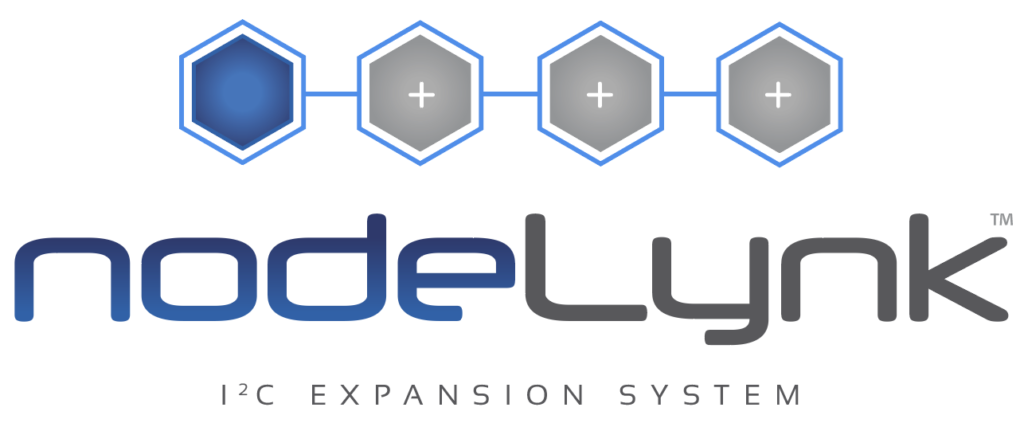
What is nodeLynk?
Chain expansion devices using nodeLynk. Connect a wide variety of accessories to expand the capabilities of a nodeLynk compatible controller. Use nodeLynk to add Relay Controllers, Sensors, PWM Drivers, Displays, and a wide variety of 4-20mA, 0-10V ADCs and DACs, as well as a wide array of TTL & Isolated GPIO devices. All nodeLynk devices use I2C communications to chain devices together. nodeLynk is an easy way to expand functionality without soldering. nodeLynk allows expansion in seconds so you can focus on your software and firmware development.

Unlimited I2C Expansion
Based on our plug-and-play nodeLynk I2C interface standard, all NCD IoT devices are equipped with a nodeLynk I2C expansion port, making it easy to expand to a wide variety of sensors, current monitors, relay controllers, PWM controllers, and much more! We are always designing new nodeLynk expansions for our plug-and-play nodeLynk I2C framework. We are dedicated to building a product line of interconnected devices to simplify all forms of automation. Re-use or upgrade your hardware in seconds by selecting the modules that best fit your needs, and chaining them together using the included nodeLynk I2C expansion cables!
Associated Part Numbers
This product may have been previously manufactured using a part number shown below:
Relay Options
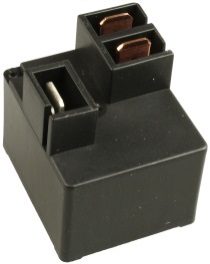
20-Amp SPDT High Power Relay Option
This controller is available with a 20-Amp relay option, allowing control of high-power loads up to an absolute maximum of 240VAC at 20 Amps. Ideal for high-power switching applications, this relay should never be used for low-power signals. The 20-Amp relay is of the SPDT variety, which provides Common (C), Normally Open (NO), and Normally Closed (NC) connections. Common is connected to NC when the relay is off. Common disconnects from NC and connects to NO when the relay is activated. This relay is Rated at 20-Amps between NO and C. Do not exceed 10-Amps between C and NC connections. This relay uses .250″ Quick Connect terminals (optional accessory) to connect to the top side of the relay. The relay is molded with COM, NC, and NO markings into the plastic. Review Datasheet
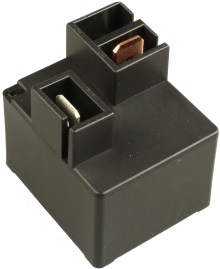
30-Amp SPST High Power Relay Option
This controller is available with a 30-Amp relay option, allowing control of high-power loads up to an absolute maximum of 240VAC at 30 Amps. Ideal for high-power switching applications, this relay should never be used for low-power signals. The 30-Amp relay is of the SPST variety, which provides Common (C) and Normally Open (NO) connections. Common has no connection when the relay is off. Common connects to NO when the relay is activated. This relay uses .250″ Quick Connect terminals (optional accessory) to connect to the top side of the relay. The relay is molded with COM, NO markings into the plastic. Review Datasheet
Mechanical Drawing
Essential
Documentation
Tutorials
- Alexa Garage Door Opener Voice Activated
- Controlling Inductive Devices: Managing Induction & Electromagnetic Interference
- Introduction to Computer Controlled Relays and Switching
- Relay Logic
Datasheets
Documentation Downloads
Official Repository
IFTTT Time Activated Relay Switch
Learn how to configure IFTTT to control Relays from NCD.io. The interface for IFTTT has changed, but this article still provides a good overview of how automation can be achieved using IFTTT without any programming.
NCD and IFTTT
Learn how NCD works with IFTTT. IFTTT is a powerful and open ended cloud solution that allows our Relay Controllers to React to Virtual data with no programming. Control Relays by email, google docs, and many other online channels.
Introduction to Relay Control
This video will guide you in determining which relay controller you need for your application as well as a general overview of the differences between Relay Options. If you’re new to our products or just need a refresher for a new application this is a great place to start.
Induction Suppression
Learn about Induction and how it comes into play with Relay Controllers. Induction suppression can make your Relay Control applications intermittent and unreliable. This video will show you what causes it, how to avoid it, and how to account for it in your application.
Hiph-Power Relay Controller Specifications
This table covers all NCD High-Power Relay Controllers. All ratings assume 12VDC operation at 70°F (21°C). Please note that most ratings are estimated and may be subject to periodic revision. Some ratings represent stock controller settings without performance enhancement optimizations. The estimated processing time can be impacted by background services and choice of commands. Standby power consumption assume no communications module is installed and no relays are active on the controller. Please add the power consumption of the activated relays and communications module to obtain a better estimation of power consumption.| Specifications of NCD SPDT Relay Controllers | Minimum | Nominal | Maximum | Notes |
|---|---|---|---|---|
| Operational Voltages | 10VDC | 12VDC | 15VDC | |
| Standby Power Consumption | 35mA | 100mA | 200mA | No Active Relays, No Com Module |
| Relay Power Consumption | 28mA | 35mA | 60mA | Consumption of Each Activated Relay |
| Operational Temperature Range | -40°F (-40°C) | 70°F (21°C) | 185°F (85°C) | Theoretical Component Limits Shown |
| Storage Temperature Range | -67°F (-55°C) | 70°F (21°C) | 185°F (85°C) | Theoretical Component Limits Shown |
| Operational Ambient Air Humidity | 0% | 50% | 70% | Non-Condensing Humidity Values Shown |
| Relay Activation Time | 15ms | Component Rating Shown | ||
| Relay Deactivation Time | 10mS | Component Rating Shown | ||
| Operational Life Mechanical | 10,000,000 | Component Operation Rating | ||
| Operational Life Electrical | 100,000 | Component Rating at Maximum Load |
Integration Notes
Relays are controlled using the MCP230xx Series Programmable GPIO Port Expanders from Microchip Technology. Relays are controlled by a MCP23017 using GPIO0:7 on Port A and GPIO0:7 on Port B. Controlling on-board relays is easy: Set GPIO0:7 as Digital Outputs. Next, set the on/off status of GPIO0:7 to activate the corresponding relays. LEDs indicate the status of on-board relays. All of these operations are handled for you when using the drivers supplied in our GitHub repository (ControlEverythingCom). Induction suppression capacitors are strongly advised for inductive switching applications (anything that generates a magnetic field). Induction suppression capacitors will prolong the life of the relays and help prevent malfunctions when switching high voltages.
IoT Interface Compatibility
NCD IoT Interface devices are designed to plug in to many popular IoT computing platforms. This allows the “brains” from other manufacturers to directly plug into our devices for easy plug-and-play operation. IoT interface devices use I²C as the underlying communications technology. The notes below will guide you into plugging 3rd party IoT technologies into our devices, we will highlight any adapters that may be required in this section. Please note that all IoT Interface Devices act as a I²C Master Device, and may be expanded by connecting to any of our Cross-Platform nodeLynk I²C Slave Devices using the nodeLynk I²C Output.
NCD IoT Interface Direct Connection
The following devices directly plug into NCD IoT Interface controllers without a adapter.
- Particle Electron
- Particle Photon (Particle.io)
- Bluz Module (Bluz.io)
- ESP8266 Module
If using a Particle Photon or Particle Electron communications module, the PKFR Key Fob Receiver overlay shield may be used to add long-range wireless Key Fob remote control to the communications module.
NCD IoT Interface Adapters
Use the following adapters will adapt the IoT Interface for I2C communications with other popular computing platforms:
- Arduino Nano using the Arduino Nano Adapter
- Arduino Micro using the Arduino Micro Adapter
- Onion Omega 1&2 using the OC Adapter
- Pycom WiPy using the WiPy Adapter
- Pycom WiPy2 & LoPy using LoPy Adapter
- Adafruit Huzzah ESP8266 using the Adafruit Huzzah Adapter
- Windows using USB Interface and the USB IoT Interface Adapter
Convert IoT to I2C Interface Devices
- This device may be converted to an I²C slave device using the I2C to IoT Interface Adapter, ideal for use with Raspberry Pi, Beaglebone, Arduino Uno, and BridgeX5.
Arduino Interface
- Use the I2C to IoT Interface Adapter and a Arduino Uno Interface Adapter
- Use the I2C to IoT Interface Adapter and a Arduino Nano I²C Shield
- Use the I2C to IoT Interface Adapter and plug into any Arduino Nano Master Device
- Use the I2C to IoT Interface Adapter and plug into any Arduino Micro Master Device
- Use the I2C to IoT Interface Adapter and plug into any Arduino Due Master Device
BeagleBone Interface
- Use the I2C to IoT Interface Adapter and a BeagleBone I²C Interface Adapter
Banana Pi Interface
- Use the I2C to IoT Interface Adapter and a Banana Pi I²C Interface Adapter
C.H.I.P. Interface
- Use the I2C to IoT Interface Adapter and a C.H.I.P. I²C Interface Adapter
Raspberry Pi Interface
- Use the I2C to IoT Interface Adapter and a Raspberry Pi I²C Interface Adapter
- Use the I2C to IoT Interface Adapter and a Raspberry Pi 2/3 I²C Interface Adapter
- Use the I2C to IoT Interface Adapter and a Raspberry Pi Zero I²C Interface Adapter
Windows 8/10 PC Interface
- Use the I2C to IoT Interface Adapter and a USB to I2C Converter
- Use the I2C to IoT Interface Adapter and a BridgeX5 Series Controller
Key Fob Compatibility
NCD IoT Interface devices are also compatible with a 418MHz Key Fob receiver (Part Number: PKFR), allowing your Particle Electron, Photon, or Bluz to receive and process remote Key Fob commands up to 750 feet away. Up to 40 remote controls may be associated to the PKFR. Program your IoT communications module to receive wireless remote control commands using a Key Fob. Compatible with 1, 2, 3, 4, 5, and 8-Button MS Series Key Fobs from Linx Technologies.
Out of stock

